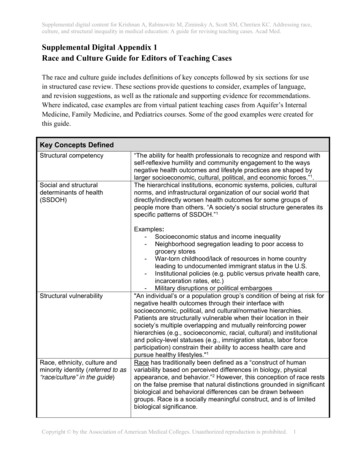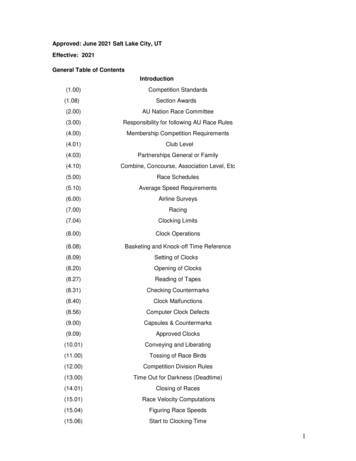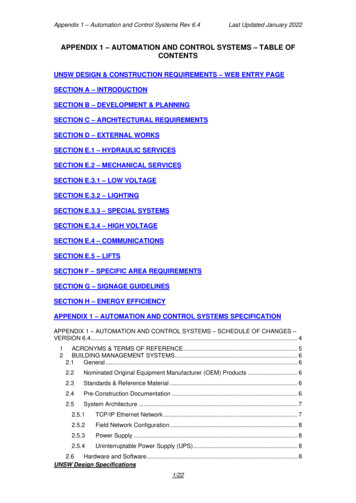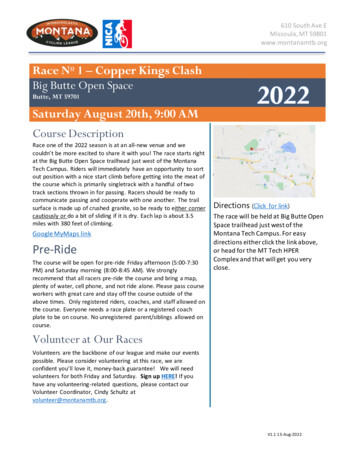
Transcription
Supplemental digital content for Krishnan A, Rabinowitz M, Ziminsky A, Scott SM, Chretien KC. Addressing race,culture, and structural inequality in medical education: A guide for revising teaching cases. Acad Med.Supplemental Digital Appendix 1Race and Culture Guide for Editors of Teaching CasesThe race and culture guide includes definitions of key concepts followed by six sections for usein structured case review. These sections provide questions to consider, examples of language,and revision suggestions, as well as the rationale and supporting evidence for recommendations.Where indicated, case examples are from virtual patient teaching cases from Aquifer’s InternalMedicine, Family Medicine, and Pediatrics courses. Some of the good examples were created forthis guide.Key Concepts DefinedStructural competencySocial and structuraldeterminants of health(SSDOH)Structural vulnerabilityRace, ethnicity, culture andminority identity (referred to as“race/culture” in the guide)“The ability for health professionals to recognize and respond withself-reflexive humility and community engagement to the waysnegative health outcomes and lifestyle practices are shaped bylarger socioeconomic, cultural, political, and economic forces.”1.The hierarchical institutions, economic systems, policies, culturalnorms, and infrastructural organization of our social world thatdirectly/indirectly worsen health outcomes for some groups ofpeople more than others. “A society’s social structure generates itsspecific patterns of SSDOH.”1Examples:- Socioeconomic status and income inequality- Neighborhood segregation leading to poor access togrocery stores- War-torn childhood/lack of resources in home countryleading to undocumented immigrant status in the U.S.- Institutional policies (e.g. public versus private health care,incarceration rates, etc.)- Military disruptions or political embargoes"An individual’s or a population group’s condition of being at risk fornegative health outcomes through their interface withsocioeconomic, political, and cultural/normative hierarchies.Patients are structurally vulnerable when their location in theirsociety’s multiple overlapping and mutually reinforcing powerhierarchies (e.g., socioeconomic, racial, cultural) and institutionaland policy-level statuses (e.g., immigration status, labor forceparticipation) constrain their ability to access health care andpursue healthy lifestyles."1Race has traditionally been defined as a “construct of humanvariability based on perceived differences in biology, physicalappearance, and behavior.”2 However, this conception of race restson the false premise that natural distinctions grounded in significantbiological and behavioral differences can be drawn betweengroups. Race is a socially meaningful construct, and is of limitedbiological significance.Copyright by the Association of American Medical Colleges. Unauthorized reproduction is prohibited.1
Supplemental digital content for Krishnan A, Rabinowitz M, Ziminsky A, Scott SM, Chretien KC. Addressing race,culture, and structural inequality in medical education: A guide for revising teaching cases. Acad Med.The concept of ethnicity is an attempt to further differentiate racialgroups and account for diversity within the population; however, likerace, it carries its own historical, political, and social baggage.“Common threads that may tie one to an ethnic group include skincolor, religion, language, customs, ancestry, and occupational orregional features. In addition, persons belonging to the same ethnicgroup share a unique history different from that of other ethnicgroups. Usually a combination of these features identifies an ethnicgroup.”2“The concept of culture as distinct from race/ethnicity has beenproposed as a better explanation for differences in health behaviorand health outcomes. Culture is defined as integrated patterns ofhuman behavior that include the language, thoughts,communications, actions, customs, beliefs, values, and institutionsof racial, ethnic, religious, or social groups. Culture can betransmitted intergenerationally. Culture in the context of healthbehavior has been defined as “unique shared values, beliefs, andpractices that are directly associated with a health-related behavior,indirectly associated with a behavior, or influence acceptance andadoption of the health education message.”3Importantly, knowing someone's ethnic identity or national origindoes not reliably predict beliefs and attitudes. In most instances, thedefinition of culture is nebulous and imprecise. Inferring that certainhealth behaviors or outcomes differ by race, ethnicity, culture, maybe misleading because they rarely account for the distinctdifferences within racial or ethnic groups or cultures.Reductionism andessentialismThe term minority refers to “a group of people who, because of theirphysical or cultural characteristics, are singled out from the othersin the society in which they live for differential and unequaltreatment, and who therefore regard themselves as objects ofcollective stigma and discrimination. The existence of a minority ina society implies the existence of a corresponding dominant groupenjoying higher social status and greater privileges.” Characteristicsthat have been linked to minority group identity include sex, gender,sexual orientation, disability, ethnicity, nationality, race, language,culture, and religion. As a result, an individual who is a member ofmore than one defined minority group may be multiply stigmatized.4Reductionism is the process by which “complex phenomena arepartitioned into smaller segments that are then dealt withpiecemeal.”5 In medicine, we use reductionism to represent wholelives of people as racial, or ethnic, or cultural minutiae. Often, thisresults in a loss of understanding of unique and shared experiencesof people from minority backgrounds. Reducing ethnicities andcultures to a single category comprised of a checklist of itemsresults in a single story, which creates stereotypes that may not justbe untrue, but are also incomplete. This single story not onlyperpetuates stereotypes but also prevents delivery of adequate,necessary and equitable care.Copyright by the Association of American Medical Colleges. Unauthorized reproduction is prohibited.2
Supplemental digital content for Krishnan A, Rabinowitz M, Ziminsky A, Scott SM, Chretien KC. Addressing race,culture, and structural inequality in medical education: A guide for revising teaching cases. Acad Med.Implicit biasCritical consciousnessEssentialism is a concept that refers to defining and classifying aperson’s “true and fixed essence.”5 In the context of culture,essentialism is the practice of categorizing groups of people withina culture, or from other cultures, according to essential qualities.However, through processes like diagnosis and “labelling”, we arelikely to assume that patients carry this “named status” into everyaspect of their lives.5“Stereotypes are the belief that most members of a group havesome characteristic. Some examples of stereotypes are the beliefthat women are nurturing or the belief that police officers likedonuts. An explicit stereotype is the kind that you deliberately thinkabout and report. An implicit stereotype is one that is relativelyinaccessible to conscious awareness and/or control. Even if yousay that men and women are equally good at math, it is possiblethat you associate math more strongly with men without beingactively aware of it. In this case we would say that you have animplicit math men stereotype.”6“Critical consciousness refers to the process by which individualsapply critical thinking skills to examine their current situations,develop a deeper understanding about their concrete reality, anddevise, implement, and evaluate solutions to their problems. Criticalconsciousness is a key ingredient for positive behavior change. It isa state of understanding how power and difference shape socialstructure and interaction. It has two components: anti-oppressivethinking and anti-oppressive action.”7Key concept references1.2.3.4.5.6.7.Bourgois P, Holmes SM, Sue K, Quesada J. Structural vulnerability: Operationalizing the concept to addresshealth disparities in clinical care. Academic Medicine. 2017;92(3):299-307.Oppenheimer, GM. Paradigm lost: Race, ethnicity, and the search for a new population taxonomy. AmericanJournal of Public Health. 2001;91(7):1049-55.Egede, LE. Race, ethnicity, culture, and disparities in health care. JGIM. 2006;21(6):667-669.Viladrich A, Loue S. Minority identity development. In: Loue S, ed. Sexualities and Identities of Minority Women.New York, NY: Springer; 2010.Pillay M. Cross-cultural practice: What is it really about? Folia Phoniatr Logop. 2003;55:293-299.Harvard Project Implicit. What are explicit and implicit faqs.html#faq1. Published 2011. Accessed November 27, 2018.Newark Community Collaborative Board. Framework: Critical consciousness sciousness-theory/. Published 2016. Accessed November 27, 2018.Copyright by the Association of American Medical Colleges. Unauthorized reproduction is prohibited.3
Supplemental digital content for Krishnan A, Rabinowitz M, Ziminsky A, Scott SM, Chretien KC. Addressing race,culture, and structural inequality in medical education: A guide for revising teaching cases. Acad Med.Section 1. Racial and ethnic health disparities are caused by social and structural determinants ofhealth (SSDOH) and not based in genetics or biology.Does your case include:[[[[] A patient of color and/or minority ethnicity?] References to race and/or ethnicity as risk factors for disease?] Race and/or ethnicity as a criteria for screening?] Race and/or ethnicity in summary statements or medical documentation?Suggested case edits:[ ] Race/ ethnicity/ sexual orientation/ cultural-identifier/ etc. should rarely, if ever, be listed in medicaldocumentation or summary statements: Descriptive identifiers in the summary statement (i.e. “Spanish-speaking”, “MSM”, “AfricanAmerican”, “Caucasian women”) should only be included if evidence exists in the literature fortheir relevance to clinical decision-making and improved patient outcomes for this particularclinical situation. Good example: Obstetrics student asks about history of thalassemia in persons of Italian,Greek, Mediterranean or Asian descent. Summary statement: “22yo healthy G1P0 with familyhistory of thalassemia and Greek ancestry” (Revised from Family Medicine, Case 14).[ ] Provide brief explanation for racial and/or ethnic health disparities when mentioned in cases: Explanations should be included for both sections on “Risk factors” and “Screening criteria” Explicitly state whether racial and/or ethnic health disparities are social/ structural versusgenetic/ biological Good example: “Diabetes screening is indicated for Native American, African-American,Hispanic American, Asian/South Pacific Islander race,” as per USPSTF, American DiabetesAssociation and American Association of Clinical Endocrinology guidelines, based on the factthat there is higher prevalence of DM within these populations. This may be because thesepopulations are disproportionately exposed to SSDOH which increase the risk fordevelopment of DM. (Revised from Pediatrics, Case 4)[ ] Provide the evidence: A literature search will show that for many diseases, a racial disparity in outcomes exists inthe US. This should be highlighted, but the reason for the disparity must be clearly identifiedas a result of SSDOH (e.g. housing, jobs, etc.). Include the latest data on racial and ethnic health disparities for common diseases and healthstatus indicators (e.g. breast cancer, cervical cancer, colorectal cancer, breastfeeding rates,etc.) in both cases with and without patients of color.Rationale and evidence for case edits: When the cause of a racial/ethnic health disparity is not known, we must be careful not toattribute these disparities to genetics/biology as evidence points to social/structuraldeterminants having a greater impact on disparities than genetics.1Social/structural risk factors are modifiable, so attributing them to race/ethnicity eliminatespossibility of intervention.Visual assessments of patient’s race are not evidence-based and are often inaccurate;evidence demonstrates that patient harm can occur when visual assessment is used toCopyright by the Association of American Medical Colleges. Unauthorized reproduction is prohibited.4
Supplemental digital content for Krishnan A, Rabinowitz M, Ziminsky A, Scott SM, Chretien KC. Addressing race,culture, and structural inequality in medical education: A guide for revising teaching cases. Acad Med. identify patient race and then to guide clinical decision-making.1Race is a false surrogate for genetic/biological makeup (e.g. person who “looks white” mayhave one African great-grandparent and therefore 1/8 chance of inheriting that ancestor’ssickle-cell mutation).2References1. Acquaviva KD, Mintz M. Perspective: Are we teaching racial profiling? The dangers of subjective determinations ofrace and ethnicity in case presentations. Academic Medicine. 2010;85(4):702-5.2. Braun L, Saunders B. Avoiding racial essentialism in medical science curricula. AMA Journal of Ethics.2017;19(6):518-527.Section 2. Providers should look to SSDOH to understand patient behaviors, rather than attributingpatient behavior to patient’s race/culture.Does your case include:[ ] A patient of color and/or minority culture?[ ] A patient of low socioeconomic status?[ ] A patient who exhibits behaviors, such as not following treatment recommendations, missinghealth appointments, poor diet, lack of exercise, smoking, alcohol or other substance use, or sexualrisk behaviors?[ ] Discussion or counseling regarding patient health behavior?Suggested case edits:[ ] Within provider-patient discussions, have the provider and/or medical student explore theupstream factors affecting the patient’s behaviors, including but not limited to not following treatmentrecommendations, missing health appointments, poor diet, lack of exercise, smoking, alcohol or othersubstance use, or sexual risk behaviors, at least once. Provider goes beyond individual patient behaviors and probes on SSDOH at least once whiletaking history Good example: If patient is not following provider recommendations, provider probesthe root cause(s) by asking “why” at least five times.1 Provider encourages student to ask at least one social context question while taking history. Good example: Patient: “I can’t come to a hospital follow-up appointment.” Provider: “What is getting in your way of coming to an appointment?” Patient: “I don’t have any way to get there and it’s 3 miles away” Provider: “Why don’t you have any way to get there?” Patient: “My husband used to drive me but he isn’t here anymore.” Provider: “Why isn’t he around?” Patient: “He just got deported again. We’re undocumented” Provider: “That sounds really difficult. We can help you get a subsidized bus passtoday and have one of our social workers set you up resources and connect you to animmigration law firm. We also have a great family support group, if you’re able tocome. What else can we do to help right now?”[ ] Place health behaviors (e.g. smoking, poor diet, sedentary lifestyle, etc.) within the SSDOHcontext when the health behavior is listed as a “risk factor” for disease: Good example: Discussion of U.S. adolescent obesity trends by race, which attributesdifferences in obesity rates to “increased consumption of processed food" (Family Medicine,Copyright by the Association of American Medical Colleges. Unauthorized reproduction is prohibited.5
Supplemental digital content for Krishnan A, Rabinowitz M, Ziminsky A, Scott SM, Chretien KC. Addressing race,culture, and structural inequality in medical education: A guide for revising teaching cases. Acad Med. Case 21), is expanded to include root causes of this dietary behavior, including a discussionof neighborhood food deserts, lack of access to affordable healthy foods, disparities withinschool systems and housing, and other structural etiologies of this health disparity.Good example: Inability to follow provider recommendations is framed as an issue of socialcontext, not an individual patient behavior problem.[ ] Remove and replace language in which the “health behavior” is used as an adjective to describethe patient: Good example: “homeless man” is replaced by “man experiencing homelessness” Good example: “drug addict” or “substance abuse” is replaced with “woman with substanceuse disorder”[ ] Provide the evidence: Literature is cited showing that upstream context questions are helpful inmanaging care for both minority and non-minority patients. Good example: Author includes discussion and literature supporting the role of upstreamcontext (not race/culture) in shaping patient’s dietary behaviors.Rationale and evidence for case edits: Health behaviors do not define individuals; racial identity does not predispose individuals tocertain behaviors, social circumstances do.Attributing illness to patient behavior without acknowledging social context prevents studentsfrom understanding the root causes of health disparities and perpetuates racial and culturalbiases.Students understand that health behaviors are often modifiable and social context-driven;students feel empowered to ask about SSDOH and to work to address patients’ poor healthbehaviors in a structurally competent manner.2,3Medical education using patient cases should teach structural humility by not placing blamefor illness onto individual patients and their behaviors, but instead on to their circumstances/upstream social context of their lives.4Health care providers must model empathy and how to address patients’ poor healthbehaviors in a structurally competent manner.2References1. Leveson NG. Applying systems thinking to analyze and learn from events. Saf Sci. 2011;49:55–64.2. Rogers B. With understanding comes empowerment. New /With Understanding Comes Empowerment/1696112/206876/article.html.Published April 2014. Accessed November 28, 2018.3. Metzl JM, Hansen H. Structural competency: Theorizing a new medical engagement with stigma and inequality.Social Science & Medicine. 2014;103:126-33.4. Tervalon M, Murray-García J. Cultural humility versus cultural competence. J Health Care Poor Underserved.1998;9(2):117-125.Section 3. Description of patients’ histories, health beliefs, and practices should direct attention tounique patient circumstances and SSDOH, as opposed to racial/cultural stereotypes.Does your case include:[ ] A patient of color and/or minority culture?[ ] Attribution of a patient’s health belief or practice to cultural values, beliefs or practices?[ ] Guidance on how to approach minority patients (based on their “unique belief systems” as agroup)?Copyright by the Association of American Medical Colleges. Unauthorized reproduction is prohibited.6
Supplemental digital content for Krishnan A, Rabinowitz M, Ziminsky A, Scott SM, Chretien KC. Addressing race,culture, and structural inequality in medical education: A guide for revising teaching cases. Acad Med.Suggested case edits:[ ] Cases should be written such that minority patients are not automatically assumed to be “theother” (racially/culturally different from the case author, physician or medical student): Consider how a physician from the same racial/ cultural background as the patient mightinteract with this patient. Explore whether the case might be written differently from that point of view. (Considerlanguage like “we”, “they”, etc.)[ ] Avoid use of patient’s racial/cultural identity as a harbinger of pathology covered later in the case: Mentioning relevant SSDOH and health disparities for certain pathologies is important, butstrive to include a variety of different portrayals of minority patients (not always giving thempathologies classically associated with their race/culture). Good example: A black child is found to have leukemia, instead of sickle cell disease. Good example: A trans woman is found to have meningitis, instead of HIV/AIDS.[ ] Exercise caution and restraint when offering instructions on how to approach patients based solelyon their racial/cultural identity: Ask patients about their beliefs, instead of assuming that because they are Latino, theybelieve in fatalismo (fatalism), for instance. A Latino patient may still report a belief infatalismo, but the physician must model how to inquire about each patient’s belief system,regardless of patient’s race/culture. If instructions are offered, provide evidence that this assumption-based approach improvespatient care/outcomes. Good example: A patient self-identifies as a queer female teenager, so the physicianasks for the patient’s preferred gender pronouns. Then, evidence is provided thatasking this question improves care for LGBTQ teens. All patients, rather than exclusively minority patients, should be asked about their beliefsystems when relevant.[ ] Patients of color and/or minority culture should exhibit a broad variety of healthy and unhealthybehaviors, avoiding exclusively unhealthy, stereotypical behaviors for minority patients: While racial/ethnic health disparities are important to understand, patients of color should notexclusively be depicted with obesity, under-insured status, diabetes, poverty, etc., as thisreinforces implicit biases and worsens health outcomes.1 Good example: A Latino couple brings their 7yo daughter in for DKA. By history, parents aremiddle-class, born and raised in the U.S., speak only English, exercise, and eat healthy.Health disparities related to DKA are discussed later in the case, but this patient’s HPI doesnot fall back on cultural stereotypes/ implicit biases, instead adding diversity to our portrayal ofLatino families. Furthermore, the didactic content on DKA is not impacted by this revision(Revised from Pediatrics, Case 16).[ ] Foster critical consciousness whenever assumptions are made about patients based on racial/cultural identity: Good example: Medical student interviews RR, a black female with obesity. In his oralpresentation, he suggests helping RR get food stamps so that she can afford healthier food.The physician challenges the student to talk more with RR about her barriers to weight loss,and he learns that instead of access to healthy food (as he had assumed), RR’s biggestbarrier to weight loss is her long work hours as a bank executive sitting at a desk.Copyright by the Association of American Medical Colleges. Unauthorized reproduction is prohibited.7
Supplemental digital content for Krishnan A, Rabinowitz M, Ziminsky A, Scott SM, Chretien KC. Addressing race,culture, and structural inequality in medical education: A guide for revising teaching cases. Acad Med.[ ] Case images/ photos: Consider any implicit messages that images convey; does the depiction of a patient of colorserve as a hint at what is to come later in the case (e.g. that a certain pathology will bediscussed, or that a stereotypical set of SSDOH will be encountered)? Consider re-shooting photographs with a more diverse group of providers/patients/students,or finding more diverse open source Google images.[ ] Provide the evidence: Literature is cited for health disparities that do exist for pathologies discussed in the case,regardless of this particular patient’s race/culture, with brief discussion of structural/ upstreamfactors. Links/references are offered to evidence the potential for medical harm that arises whenassumptions are made about patients based on their perceived race/culture.Rationale and evidence for case edits: Students must be exposed to alternative portrayals of minority patients that move beyondreductionist views and exemplify the diversity within minority groups.Medical education must minimize essentialism.2Structural competency skills are best learned when demonstrated in practice. The structuralcontext in which patients live should be incorporated into the disease narrative as this mayexpose a modifiable risk factor, different from those associated with the patient’s stereotype.Race in and of itself is not necessarily a biological risk factor. However, the social context ofracism can be a risk factor, which has led to certain health behaviors, disease prevalence,and health outcomes being commonly associated with certain races and cultures.3While it is critical to learn how to understand, model empathy, and effectively communicatewith people of different races and cultures, these provider-patient communication tacticsshould be taught and practiced because they are medically relevant and lead to improvedhealth outcomes, not because a patient is a member of a racial/cultural group for whichstereotypes exist (i.e. the same questions regarding patients’ health beliefs can and shouldtheoretically be used for minority and non-minority races and cultures).4References1. Acquaviva KD, Mintz M. Perspective: Are we teaching racial profiling? The dangers of subjective determinations ofrace and ethnicity in case presentations. Academic Medicine. 2010;85(4):702-5.2. Kumas-Tan Z, Beagan B, Loppie C, MacLeod A, Frank B. Measures of cultural competence: Examining hiddenassumptions. Academic Medicine. 2007;82(6):548-57.3. Metzl JM, Roberts DE. Structural competency meets structural racism: Race, politics, and the structure of medicalknowledge. Virtual Mentor. 2014;16(9):674-690.4. Wear D. Insurgent multiculturalism: Rethinking how and why we teach culture in medical education. AcademicMedicine. 2003;78(6):549-54.Section 4. Treatment plan should include addressing patients’ SSDOH.Does your case include:[ ] A patient and a health care provider?Suggested case edits:[ ] Provider demonstrates personal responsibility for addressing SSDOH at least once in theCopyright by the Association of American Medical Colleges. Unauthorized reproduction is prohibited.8
Supplemental digital content for Krishnan A, Rabinowitz M, Ziminsky A, Scott SM, Chretien KC. Addressing race,culture, and structural inequality in medical education: A guide for revising teaching cases. Acad Med.Assessment and Plan when social context risk factors are identified, other than referrals to otherdisciplines such as social work: Good short-term examples: Food bank referral Bus pass Directions to homeless shelter If low health literacy, visual (e.g. whiteboard) education offered /- reading/writingassistance Connection to local or online support group Other local resources suggested Good long-term examples: Provider supports student idea to restructure the clinic schedule to improve access(e.g. create more drop-in/ evening hours). Student research/ quality improvement project suggested and encouraged at clinic orin community. Partnership with community based organization and future collaborative communityevents are considered. Good individual patient-level examples: Provider explicitly practices trauma-informed care, uses non-judgmental language, andrespects patient autonomy. Provider calls drug or insurance company to get cheaper drug price for patient. Provider requests in-person interpreter for next appointment. Good population-level examples: Provider encourages student to write letter to representative, participate in governmentlobby day, or get involved with relevant non-profit organization.[ ] Hopelessness/ futility in addressing SSDOH is called out and explicitly mitigated: Good example: Provider acknowledges the challenges of this work and emphasizes the needfor creativity given no established treatment algorithms. Good example: If student expresses hopelessness about SSDOH, provider responds withoptimism and solutions. Remove text that express a sense of futility in addressing SSDOH. Good example: Removal of text: “You feel uncomfortable with him going back to the streetsafter this life-threatening illness, but it becomes clear that there is no alternative“ (InternalMedicine, Case 26).[ ] Provider models interdisciplinary team care at least once in the case. Provider refers patient to interdisciplinary team, engages in conversation with other healthprofessionals, and does not defer all responsibility for addressing SSDOH to other teammembers. Interdisciplinary team care is modeled as a structural tool for addressing SSDOH. Good example: Demonstrate conversations between providers and other health professionals,such as nurses, social work, physical therapists, and behavioral counselors that depictmultiple professions working towards the same ultimate goal.[ ] Provider is an active community advocate. Good example: Dr. Lee says “school food is so unhealthy” (Family Medicine, Case 21) anddescribes advocating for removal of vending machines from grade schools.[ ] Provide the evidence:Copyright by the Association of American Medical Colleges. Unauthorized reproduction is prohibited.9
Supplemental digital content for Krishnan A, Rabinowitz M, Ziminsky A, Scott SM, Chretien KC. Addressing race,culture, and structural inequality in medical education: A guide for revising teaching cases. Acad Med. Literature is cited for why addressing SSDOH in the Assessment and Plan is necessary toimprove patient outcomes.Literature is cited to provide evidence regarding successful interventions used in similarsituations.Literature is cited to provide evidence that a team-based approach leads to improved patientoutcomes, quality and satisfaction in case, fewer adverse events, and solutions to SSDOH.[ ] Website links to resources are provided. Links to national organizations, NGOs, and community-based organizations that havemodeled structural competency interventions in practice Good example: Health Leads (https://healthleads
Implicit bias "Stereotypes are the belief that most members of a group have some characteristic. Some examples of stereotypes are the belief that women are nurturing or the belief that police officers like donuts. An explicit stereotype is the kind that you deliberately think about and report. An implicit stereotype is one that is relatively











